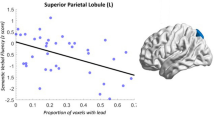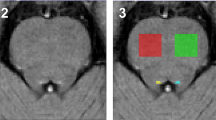Abstract
Cerebral reorganization during recovery after stroke has been investigated using functional imaging in patients with subcortical motor stroke. The functional correlates of recovery from anarthria, however, are yet unknown. A 48-year-old male patient recovering from complete anarthria after unilateral right-sided subcortical hemorrhagic stroke is described. The main outcome measures included clinical and neuroimaging data at three different time points (at the onset of symptoms, after 6 weeks and after 6 months). At 6 weeks, increased activations in the right and left frontal operculum were found and were followed by a trend towards normalization of the activation pattern at 6 months. These results suggest a role of anterior opercular regions in recovery from anarthria after subcortical stroke. Moreover, complete recovery is possible after such lesions.


Similar content being viewed by others
References
Assal G, Perentes E, Deruaz JP (1981) Crossed aphasia in a right-handed patient. Postmortem findings. Arch Neurol 38:455–458
Behrens TE, Johansen-Berg H, Woolrich MW, Smith SM, Wheeler-Kingshott CA, Boulby PA, Barker GJ, Sillery EL, Sheehan K, Ciccarelli O, Thompson AJ, Brady JM, Matthews PM (2003) Non-invasive mapping of connections between human thalamus and cortex using diffusion imaging. Nat Neurosci 6:750–757
Bell DS (1968) Speech functions of the thalamus inferred from the effects of thalamotomy. Brain 91:619–638
Bogousslavsky J, Regli F (1990) Capsular genu syndrome. Neurology 40:1499–1502
Calautti C, Baron JC (2003) Functional neuroimaging studies of motor recovery after stroke in adults: a review. Stroke 34:1553–1566
Crosson B (1984) Role of the dominant thalamus in language: a review. Psychol Bull 96:491–517
Crosson B (1985) Subcortical functions in language: a working model. Brain Lang 25:257–292
Crosson B (1999) Subcortical mechanisms in language: lexical-semantic mechanisms and the thalamus. Brain Cogn 40:414–438
Crosson B, Benefield H, Cato MA, Sadek JR, Moore AB, Wierenga CE, Gopinath K, Soltysik D, Bauer RM, Auerbach EJ, Gokcay D, Leonard CM, Briggs RW (2003) Left and right basal ganglia and frontal activity during language generation: contributions to lexical, semantic, and phonological processes. J Int Neuropsychol Soc 9:1061–1077
Duffau H, Denvil D, Capelle L (2002) Absence of movement disorders after surgical resection of glioma invading the right striatum. J Neurosurg 97:363–369
Duffau H, Karachi C, Gatignol P, Capelle L (2003) Transient Foix–Chavany–Marie syndrome after surgical resection of a right insulo-opercular low-grade glioma: case report. Neurosurgery 53:426–431
Foix C, Chavany JA, Marie J (1926) Diplégie facio-linguo-masticatrice d’origine cortico-sous-corticale sans paralysie des membres. Rev Neurol (Paris) 33:214–219
Geschwind N (1965) Disconnexion syndromes in animals and man. I. Brain 88:237–294
Geschwind N (1965) Disconnexion syndromes in animals and man. II. Brain 88:585–644
Gil RS, Gatignol P, Capelle L, Mitchell MC, Duffau H (2005) The role of dominant striatum in language: a study using intraoperative electrical stimulations. J Neurol Neurosurg Psychiatry 76:940–946
Huber W, Klingenberg G, Poeck K, Willmes K (1993) Die supplemente zum aachener aphasie test—aufbau and resultate der validierung. Neurolinguistik 7:43–66
Huber W, Poeck K, Weniger D, Willmes K (1983) Aachener Aphasie Test (AAT). Hogrefe, Goettingen
Johnson MD, Ojemann GA (2000) The role of the human thalamus in language and memory: evidence from electrophysiological studies. Brain Cogn 42:218–230
Kho KH, Indefrey P, Hagoort P, van Veelen CW, van Rijen PC, Ramsey NF (2008) Unimpaired sentence comprehension after anterior temporal cortex resection. Neuropsychologia 46:1170–1178
Kho KH, Leijten FS, Rutten GJ, Vermeulen J, Van RP, Ramsey NF (2005) Discrepant findings for Wada test and functional magnetic resonance imaging with regard to language function: use of electrocortical stimulation mapping to confirm results. Case report. J Neurosurg 102:169–173
Mao CC, Coull BM, Golper LA, Rau MT (1989) Anterior operculum syndrome. Neurology 39:1169–1172
Nelles G, Spiekramann G, Jueptner M, Leonhardt G, Muller S, Gerhard H, Diener HC (1999) Evolution of functional reorganization in hemiplegic stroke: a serial positron emission tomographic activation study. Ann Neurol 46:901–909
Penfield W, Boldrey E (1937) Somatic motor and sensory representation in the cerebral cortex of man as studied by electrical stimulation. Brain 60:389–443
Saur D, Lange R, Baumgaertner A, Schraknepper V, Willmes K, Rijntjes M, Weiller C (2006) Dynamics of language reorganization after stroke. Brain 129:1371–1384
Starkstein SE, Berthier M, Leiguarda R (1988) Bilateral opercular syndrome and crossed aphemia due to a right insular lesion: a clinicopathological study. Brain Lang 34:253–261
Stippich C, Rapps N, Dreyhaupt J, Durst A, Kress B, Nennig E, Tronnier VM, Sartor K (2007) Localizing and lateralizing language in patients with brain tumors: feasibility of routine preoperative functional MR imaging in 81 consecutive patients. Radiology 243:828–836
Ter KM, Brown CM, Hagoort P, Stegeman DF (1999) Electrophysiological manifestations of open- and closed-class words in patients with Broca’s aphasia with agrammatic comprehension. An event-related brain potential study. Brain 122(Pt 5):839–854
Tombari D, Loubinoux I, Pariente J, Gerdelat A, Albucher JF, Tardy J, Cassol E, Chollet F (2004) A longitudinal fMRI study: in recovering and then in clinically stable sub-cortical stroke patients. Neuroimage 23:827–839
Ulmer JL, Hacein-Bey L, Mathews VP, Mueller WM, DeYoe EA, Prost RW, Meyer GA, Krouwer HG, Schmainda KM (2004) Lesion-induced pseudo-dominance at functional magnetic resonance imaging: implications for preoperative assessments. Neurosurgery 55:569–579
Ulmer JL, Krouwer HG, Mueller WM, Ugurel MS, Kocak M, Mark LP (2003) Pseudo-reorganization of language cortical function at fMR imaging: a consequence of tumor-induced neurovascular uncoupling. AJNR Am J Neuroradiol 24:213–217
Vassal M, Le BE, Moritz-Gasser S, Menjot N, Duffau H (2010) Crossed aphasia elicited by intraoperative cortical and subcortical stimulation in awake patients. J Neurosurg 113:1251–1258
Warburton E, Price CJ, Swinburn K, Wise RJ (1999) Mechanisms of recovery from aphasia: evidence from positron emission tomography studies. J Neurol Neurosurg Psychiatry 66:155–161
Ward NS, Brown MM, Thompson AJ, Frackowiak RS (2003) Neural correlates of motor recovery after stroke: a longitudinal fMRI study. Brain 126:2476–2496
Wassenaar M, Brown CM, Hagoort P (2004) ERP effects of subject-verb agreement violations in patients with Broca’s aphasia. J Cogn Neurosci 16:553–576
Weller M (1993) Anterior opercular cortex lesions cause dissociated lower cranial nerve palsies and anarthria but no aphasia: Foix-Chavany-Marie syndrome and “automatic voluntary dissociation” revisited. J Neurol 240:199–208
Wise RJ, Greene J, Buchel C, Scott SK (1999) Brain regions involved in articulation. Lancet 353:1057–1061
Conflicts of interest
The authors report no conflicts of interest.
Ethical standard
This study has been approved by the appropriate ethics committee and has therefore been performed in accordance with the ethical standards laid down in the 1964 Declaration of Helsinki.
Author information
Authors and Affiliations
Corresponding author
Additional information
T. Theys, S. Van Cauter, K. H. Kho contributed equally to the manuscript.
Rights and permissions
About this article
Cite this article
Theys, T., Van Cauter, S., Kho, K.H. et al. Neural correlates of recovery from Foix–Chavany–Marie syndrome. J Neurol 260, 415–420 (2013). https://doi.org/10.1007/s00415-012-6641-0
Received:
Revised:
Accepted:
Published:
Issue Date:
DOI: https://doi.org/10.1007/s00415-012-6641-0




